An Extenics-Based Scheduled Configuration Methodology for Low-Carbon Product Design in Consideration of Contradictory Problem Solving
Abstract
:1. Introduction
2. Literature Review
2.1. Low-Carbon Product Design
2.2. Extenics—An Effective Contradictory Problem-Solving Methodology
3. Materials and Methods
3.1. A Scheduled Arrangement Model of CTs for Low-Carbon Requirements
3.1.1. Low-Carbon Requirements Analysis and the Potential Design Contradictions
3.1.2. Construction of the IFD for CTs
3.2. Contradictory Problem Solving for Low-Carbon Product Design by Extenics
3.2.1. Contradictory Problem Clarification and Formulation
 ,
,

3.2.2. Extensible and Conjugate Analysis
3.2.3. Extension Transformation for the Generation of Design Schemes
3.3. Outline of Proposed Extenics-Based Scheduled Configuration Methodology
4. Results—A Case Study of Vacuum Pump Low-Carbon Design
4.1. Implementation of Extenics-Based Scheduled Configuration Methodology for Vacuum Pump Low-Carbon Design
4.1.1. Requirements Configuration and the IFD of CTs for Vacuum Pump Low-Carbon Design
4.1.2. Design Contradiction Clarification and Formulation for Vacuum Pump Low-Carbon Design
4.1.3. Extensible and Conjugate Analysis for Design Contradictions
4.1.4. Generation of the Design Scheme Based on Extension Transformation for Vacuum Pump Low-Carbon Design
4.2. Comparative Performance Assessment against Other Design Problem-Solving Methods
5. Discussion
6. Conclusions
Author Contributions
Funding
Institutional Review Board Statement
Informed Consent Statement
Data Availability Statement
Conflicts of Interest
Abbreviations and Symbols
| CFP | Carbon footprint |
| CTs | Configuration tasks |
| DSM | Design structure matrix |
| ECs | Engineering characteristics |
| FI | Feedback information |
| IFD | Information flow diagram |
| LCD-AP(I) | Low-carbon design antithetical problem (I) |
| LCD-AP(II) | Low-carbon design antithetical problem (II) |
| LCD-IP | Low-carbon design incompatibility problem |
| MA | Configuration Matrix |
| QCs | Quality characteristics |
| QFD | Quality function deployment |
| TRIZ | Theory of inventive problem solving, a Russian acronym |
| Symbols | |
| di,j | Associated value that CTi depends on CTj |
| ωk | Relative weight of ECk |
| xi,j | The input configuration parameter for CTi provided by CTj |
| γj,k | Relational strength of QCj and ECk |
| Symbols in Extenics | |
| (1) Symbols for problems clarification and formulation | |
| M(m) | Matter–element model |
| R(r) | Relation–element model |
| A(a) | Affair–element model |
| Z(O) | Compound-element model |
| P | Design problem |
| g | Design goal |
| l | Design condition |
| (2) Symbols for extensible analysis | |
| A{A1, A2, …} | A1, A2, …are generated by the divergent analysis for A |
| A~B | A and B have correlative relationship |
| AB | A is the lower-level design goal of B in implication analysis |
| AB, AB, A//{A1,A2, …} | In opening-up analysis, put A and B together with symbol, integrate A and B into an unit with symbol, A is decomposed into A1, A2, … with symbol// |
| (3) Symbols for conjugate analysis | |
| im(Om), re(Om) | Nonmaterial part and material part of object Om |
| sf(Om), hr(Om) | Soft part and hard part of object Om |
| ngc(Om), psc(Om) | Negative and positive part of object Om about characteristic c |
| lt(Om), ap(Om) | Latent part and apparent part of object Om |
Appendix A
| CTi | Design Problem | Design Goal of the Problem | Design Condition of the Problem |
|---|---|---|---|
| CT8 | P11 = g11↑l11 P12 = g12↑l12 P13 = g13↑l13 P14 = g14↑l14 P15 = g15↑l15 P16 = g16↑l16 | reduce the volume and mass of part 1 reduce the volume and mass of part 2 reduce the volume and mass of part 15 reduce the volume and mass of part 24 reduce the volume and mass of part 18 reduce the volume and mass of part 6 | design information of part 1 design information of part 2 design information of part 15 design information of part 24 design information of part 18 design information of part 6 |
| P21 = g21↑l21 P22 = g22↑l22 | reduce the inner power consumption enhance the work efficiency | design information of part 12 working state of the vacuum pump | |
| P31 = g31↑l31 P32 = g32↑l32 | improve the reusability of the parts improve the adaptability of the parts | design information of part 1,2,6,12,15,18,24 design information of part 12, 24 | |
| P01 = ((g11,g12)^g22)↑l01 | reduce the volume and mass of part 1, 2 enhance the work efficiency | design information of part 1, 2 working state of the vacuum pump | |
| P02 = (g211^g212)↑l21 | reduce the working chamber air pressure increase the working chamber air pressure | design information of the suction and exhaust disc | |
| CT9 | P1 = g1↓l1 | maintenance of the continuous working parts | design information of continuous working parts |
| P2 = g2↓l2 | maintenance of the sealing parts | design information of sealing parts | |
| CT10 | P11 = g11↑l11 P12 = g12↑l12 | material selection of the transmission shaft material selection of the impeller | design information of the transmission shaft design information of the impeller |
| P21 = g21↑l21 P22 = g22↓l22 | improve the recycling methods for parts improve the disposal methods for parts | current recycling measures for the parts current disposal measures for the parts |
References
- Mesa, J.A.; Esparragoza, I.; Maury, H. Trends and perspectives of sustainable product design for open architecture products: Facing the circular economy model. Int. J. Precis Eng. Manuf. Green Technol. 2019, 6, 377–391. [Google Scholar] [CrossRef]
- Cagno, E.; Neri, A.; Howard, M.; Brenna, G.; Trianni, A. Industrial sustainability performance measurement systems: A novel framework. J. Clean. Prod. 2019, 230, 1354–1375. [Google Scholar] [CrossRef]
- Kellens, K.; Dewulf, W.; Overcash, M.; Hauschild, M.Z.; Duflou, J.R. Methodology for systematic analysis and improvement of manufacturing unit process life cycle inventory (UPLCI) CO2PE! initiative (cooperative effort on process emissions in manufacturing). Part 2: Case studies. Int. J. Life Cycle Assess. 2011, 17, 242–251. [Google Scholar] [CrossRef] [Green Version]
- Ceschin, F.; Gaziulusoy, I. Evolution of design for sustainability: From product design to design for system innovations and transitions. Design Stud. 2016, 47, 118–163. [Google Scholar] [CrossRef]
- He, B.; Li, F.F.; Cao, X.Y.; Li, T.Y. Product sustainable design: A review from the environmental, economic, and social aspects. J. Comput. Inf. Sci. Eng. 2020, 20, 040801. [Google Scholar] [CrossRef]
- Kuo, T.C.; Chen, H.M.; Liu, C.Y.; Tu, J.C.; Yeh, T.C. Applying multi-objective planning in low-carbon product design. Int. J. Precis. Eng. Manuf. 2014, 15, 241–249. [Google Scholar] [CrossRef]
- He, B.; Wang, J.; Huang, S.; Wang, Y. Low-carbon product design for product life cycle. J. Eng. Des. 2015, 26, 321–339. [Google Scholar] [CrossRef]
- Vukelic, D.; Boskovic, N.; Agarski, B.; Radonic, J.; Budak, I.; Pap, S.; Turk Sekulic, M. Eco-design of a low-cost adsorbent produced from waste cherry kernels. J. Clean. Prod. 2018, 174, 1620–1628. [Google Scholar] [CrossRef]
- Ahmad, S.; Wong, K.Y.; Tseng, M.L.; Wong, W.P. Sustainable product design and development: A review of tools, applications and research prospects. Resour. Conserv. Recycl. 2018, 132, 49–61. [Google Scholar] [CrossRef]
- Qureshi, M.I.; Rasiah, R.A.l.; Al-Ghazali, B.M.; Haider, M.; Jambari, H.; Iswan; Sasmoko. Modeling work practices under socio-technical systems for sustainable manufacturing performance. Sustainability 2019, 11, 4294. [Google Scholar] [CrossRef] [Green Version]
- Yang, C.Y.; Cai, W. Extenics: Theory, Method and Application; Science Press: Beijing, China, 2013. [Google Scholar]
- Chandrasegaran, S.K.; Ramani, K.; Sriram, R.D.; Horváth, I.; Bernard, A.; Harik, R.F.; Gao, W. The evolution, challenges, and future of knowledge representation in product design systems. Comput. Aided Des. 2013, 45, 204–228. [Google Scholar] [CrossRef]
- Tong, C.; Sriram, R.D. Artificial Intelligence in Engineering Design; Academic Press: Boston, MA, USA, 1992. [Google Scholar]
- Kusiak, A.; Wang, J. Decomposition of the design process. J. Mech. Des. 1993, 115, 687–695. [Google Scholar] [CrossRef]
- Browning, T.R. Applying the design structure maxtrix to system decomposition and integration problems: A review and new directions. IEEE Trans. Eng. Manag. 2001, 48, 292–306. [Google Scholar] [CrossRef] [Green Version]
- Wang, Q.; Tang, D.B.; Yin, L.L.; Salido, M.A.; Giret, A.; Xu, Y.C. Bi-objective optimization for low-carbon product family design. Robot. Cim. Int. Manuf. 2016, 41, 53–65. [Google Scholar] [CrossRef] [Green Version]
- Su, J.C.P.; Chu, C.H.; Wang, Y.T. A decision support system to estimate the carbon emission and cost of product designs. Int. J. Precis. Eng. Manuf. 2012, 13, 1037–1045. [Google Scholar] [CrossRef]
- Branker, K.; Jeswiet, J.; Kim, I.Y. Greenhouse gases emitted in manufacturing a product—A new economic model. CIRP Ann. Manuf. Technol. 2011, 60, 53–56. [Google Scholar] [CrossRef]
- He, B.; Pan, Q.J.; Deng, Z.Q. Product carbon footprint for product life cycle under uncertainty. J. Clean. Prod. 2018, 187, 459–472. [Google Scholar] [CrossRef]
- De Koning, A.; Schowanek, D.; Dewaele, J.; Weisbrod, A.; Guinée, J. Uncertainties in a carbon footprint model for detergents; quantifying the confidence in a comparative result. Int. J. Life Cycle Assess. 2009, 15. [Google Scholar] [CrossRef] [Green Version]
- Anand, A.; Wani, M.F. Product life-cycle modeling and evaluation at the conceptual design stage: A digraph and matrix approach. J. Mech. Des. 2010, 132, 091010. [Google Scholar] [CrossRef]
- Ren, S.D.; Gui, F.Z.; Zhao, Y.W.; Xie, Z.W.; Hong, H.H.; Wang, H.W. Accelerating preliminary low-carbon design for products by integrating TRIZ and Extenics methods. Adv. Mech. Eng. 2017, 9, 1–18. [Google Scholar] [CrossRef] [Green Version]
- Peng, J.; Li, W.Q.; Li, Y.; Xie, Y.M.; Xu, Z.L. Innovative product design method for low-carbon footprint based on multi-layer carbon footprint information. J. Clean. Prod. 2019, 228, 729–745. [Google Scholar] [CrossRef]
- Pigosso, D.C.A.; Ferraz, M.; Teixeira, C.E.; Rozenfeld, H. The deployment of product-related environmental legislation into product requirements. Sustainability 2016, 8, 332. [Google Scholar] [CrossRef] [Green Version]
- He, B.; Tang, W.; Huang, S.; Hou, S.C.; Cai, H.X. Towards low-carbon product architecture using structural optimization for lightweight. Int. J. Adv. Manuf. Technol. 2015, 83, 1419–1429. [Google Scholar] [CrossRef]
- Lu, Q.; Zhou, G.H.; Xiao, Z.D.; Chang, F.T.; Tian, C.L. A selection methodology of key parts based on the characteristic of carbon emissions for low-carbon design. Int. J. Adv. Manuf. Technol. 2017, 94, 3359–3373. [Google Scholar] [CrossRef]
- ISO. ISO 14040 Environmental Management-Life Cycle Assessment-Principles and Framework; International Organization for Standardization: Geneva, Switzerland, 2006. [Google Scholar]
- BSI. The Guide to PAS 2050: 2011 How to Carbon Footprint Your Products, Identify Hotspots and Reduce Emissions in Your Supply Chain; British Standards Institution: London, UK, 2011. [Google Scholar]
- Song, J.S.; Lee, K.M. Development of a low-carbon product design system based on embedded GHG emissions. Resour. Conserv. Recycl. 2010, 54, 547–556. [Google Scholar] [CrossRef]
- Zhang, X.F.; Zhang, S.Y.; Hu, Z.Y.; Yu, G.; Pei, C.H.; Sa, R.N. Identification of connection units with high GHG emissions for low-carbon product structure design. J. Clean. Prod. 2012, 27, 118–125. [Google Scholar] [CrossRef]
- Gui, F.Z.; Ren, S.D.; Zhao, Y.W.; Zhou, J.Q.; Xie, Z.W.; Xu, C.; Zhu, F. Activity-based allocation and optimization for carbon footprint and cost in product lifecycle. J. Clean. Prod. 2019, 236, 117627. [Google Scholar] [CrossRef]
- Xu, Z.Z.; Wang, Y.S.; Teng, Z.R.; Zhong, C.Q.; Teng, H.F. Low-carbon product multi-objective optimization design for meeting requirements of enterprise, user and government. J. Clean. Prod. 2015, 103, 747–758. [Google Scholar] [CrossRef]
- Zhang, C.; Huang, H.H.; Zhang, L.; Bao, H.; Liu, Z.F. Low-carbon design of structural components by integrating material and structural optimization. Int. J. Adv. Manuf. Technol. 2018, 95, 4547–4560. [Google Scholar] [CrossRef]
- Hu, L.K.; Tang, R.Z.; He, K.Y.; Jia, S. Estimating machining-related energy consumption of parts at the design phase based on feature technology. Int. J. Prod. Res. 2015, 53, 7016–7033. [Google Scholar] [CrossRef]
- Zhang, Y.; Wang, H.P.; Zhang, C. Green QFD-II: A life cycle approach for environmentally conscious manufacturing by integrating LCA and LCC into QFD matrices. Int. J. Prod. Res. 1999, 37, 1075–1091. [Google Scholar] [CrossRef]
- Bereketli, I.; Erol Genevois, M. An integrated QFDE approach for identifying improvement strategies in sustainable product development. J. Clean. Prod. 2013, 54, 188–198. [Google Scholar] [CrossRef]
- Puglieri, F.N.; Ometto, A.R.; Salvador, R.; Barros, M.V.; Piekarski, C.M.; Rodrigues, I.M.; Diegoli Netto, O. An environmental and operational analysis of quality function deployment-based methods. Sustainability 2020, 12, 3486. [Google Scholar] [CrossRef] [Green Version]
- Devanathan, S.; Ramanujan, D.; Bernstein, W.Z.; Zhao, F.; Ramani, K. Integration of sustainability into early design through the function impact matrix. J. Mech. Des. 2010, 132, 081004. [Google Scholar] [CrossRef]
- Sakao, T. A QFD-centred design methodology for environmentally conscious product design. Int. J. Prod. Res. 2007, 45, 4143–4162. [Google Scholar] [CrossRef] [Green Version]
- Cai, W.; Yang, C.Y. Basic theory and methodology on Extenics. Chin. Sci. Bull. 2013, 58, 1190–1199. [Google Scholar] [CrossRef]
- Rittel, H.W.J.; Webber, M.M. Dilemmas in a general theory of planning. Policy Sci. 1973, 4, 155–169. [Google Scholar] [CrossRef]
- Feng, Y.X.; Hao, H.; Tan, J.R.; Hagiwara, I. Variant design for mechanical parts based on extensible logic theory. Int. J. Mech. Mater. Des. 2010, 6, 123–134. [Google Scholar] [CrossRef]
- Li, J.; Zhong, S.S.; Jin, L.; Lin, L. Research on modular design methods based on extension theory. Comput. Integ. Manuf. Syst. 2006, 12, 641–647. [Google Scholar] [CrossRef]
- Li, W.J.; Song, Z.H.; Mao, E.R.; Suh, S. Using Extenics to describe coupled solutions in Axiomatic design. J. Eng. Des. 2018, 30, 1–31. [Google Scholar] [CrossRef]
- Tang, L.; Yang, C.Y.; Li, W.H. Adopting gene expression programming to generate extension strategies for incompatible problem. Neural Comput. Appl. 2016, 28, 2649–2664. [Google Scholar] [CrossRef]
- Chen, A.L.; Dong, L.; Liu, W.; Li, X.S.; Sao, T.M.; Zhang, J. Study on the mechanism of improving creative thinking capability based on Extenics. In Procedia Computer Science, Proceedings of the 3rd International Conference on Information Technology and Quantitative Management, Rio De Janeiro, Brazil, 21–24 July 2015; Gomes, L., Colcher, R., Wolcott, P., HerreraViedma, E., Shi, Y., Eds.; Elsevier Ltd.: Amsterdam, The Netherlands, 2015; pp. 119–125. [Google Scholar]
- Zhao, Y.W.; Su, N. Extension Design; Science Press: Beijing, China, 2010. [Google Scholar]
- Chen, J.; Zhao, Y.W.; Li, F.Y.; Li, J.F. Transforming bridge-based conflict resolution for product green design. J. Mech. Eng. 2010, 46, 132–142. [Google Scholar] [CrossRef]
- Olaru, A.; Olaru, S. Solving of the contradictory problem of the precision-stability by using the extenics theory. In MATEC Web of Conferences, Proceedings of the 7th International Conference on Mechanical, Industrial, and Manufacturing Technologies, Cape Town, South Africa, 1–3 February 2016; Abou, E.I., Hossein, K., Eds.; EDP Sciences: Cedex A, France, 2016; pp. 1–8. [Google Scholar]
- Zhao, Y.W.; He, L.; Hong, H.H.; Huang, X. Study on the innovation of integrating TRIZ-Extenics. J. Guangdong Univ. Technol. 2015, 32, 1–10. [Google Scholar] [CrossRef]
- Zhou, X.Y. Research on the Technological Innovation Theory and Method Based on TRIZ and Extenics. Ph.D. Thesis, Southwest Jiaotong University, Chengdu, China, 2012. [Google Scholar]
- Yang, C.Y.; Cai, W. Extenics and intelligent processing of contradictory problems. Sci. Technol. Rev. 2014, 32, 15–20. [Google Scholar] [CrossRef]
- Yang, C.Y.; Cai, W. Study on extension engineering. Eng. Sci. 2000, 2, 90–96. [Google Scholar]
- Masui, K.; Sakao, T.; Kobayashi, M.; Inaba, A. Applying quality function deployment to environmentally conscious design. Int. J. Qual. Reli. Manag. 2003, 20, 90–106. [Google Scholar] [CrossRef]
- Ren, S.D.; Gui, F.Z.; Zhao, Y.W.; Zhan, M.; Wang, W.L. An effective similarity determination model for case-based reasoning in support of low-carbon product design. Adv. Mech. Eng. 2020, 12, 1–24. [Google Scholar] [CrossRef]
- Suh, N.P. Axiomatic design theory for systems. Res. Eng. Des. 1998, 10, 189–209. [Google Scholar] [CrossRef]
- Meier, C.; Yassine, A.A.; Browning, T.R. Design process sequencing with competent genetic algorithms. J. Mech. Des. 2007, 129, 566–585. [Google Scholar] [CrossRef]
- Pahl, G.; Beitz, W.; Feldhusen, J.; Grote, K.-H. Engineering Design—A Systematic Approach, 3rd ed.; Sprinter: Berlin, Germany, 2007. [Google Scholar]
- Ilevbare, I.M.; Probert, D.; Phaal, R. A review of TRIZ, and its benefits and challenges in practice. Technovation 2013, 33, 30–37. [Google Scholar] [CrossRef]
- Chou, J.R. An ARIZ-based life cycle engineering model for eco-design. J. Clean. Prod. 2014, 66, 210–223. [Google Scholar] [CrossRef]
- Tyl, B.; Legardeur, J.; Millet, D.; Vallet, F. A comparative study of ideation mechanisms used in eco-innovation tools. J. Eng. Des. 2015, 25, 325–345. [Google Scholar] [CrossRef]
- Shah, J.J.; Smith, S.M.; Vargas-Hernandez, N. Metrics for measuring ideation effectiveness. Design Stud. 2003, 24, 111–134. [Google Scholar] [CrossRef]
- Mittal, S.; Frayman, F. Towards a generic model of configuration tasks. In Proceedings of the 11th International Joint Conference on Artificial Intelligence, Detroit, MI, USA, 20–25 August 1989; Morgan Kaufmann: San Mateo, CA, USA, 1989; pp. 1395–1401. [Google Scholar]


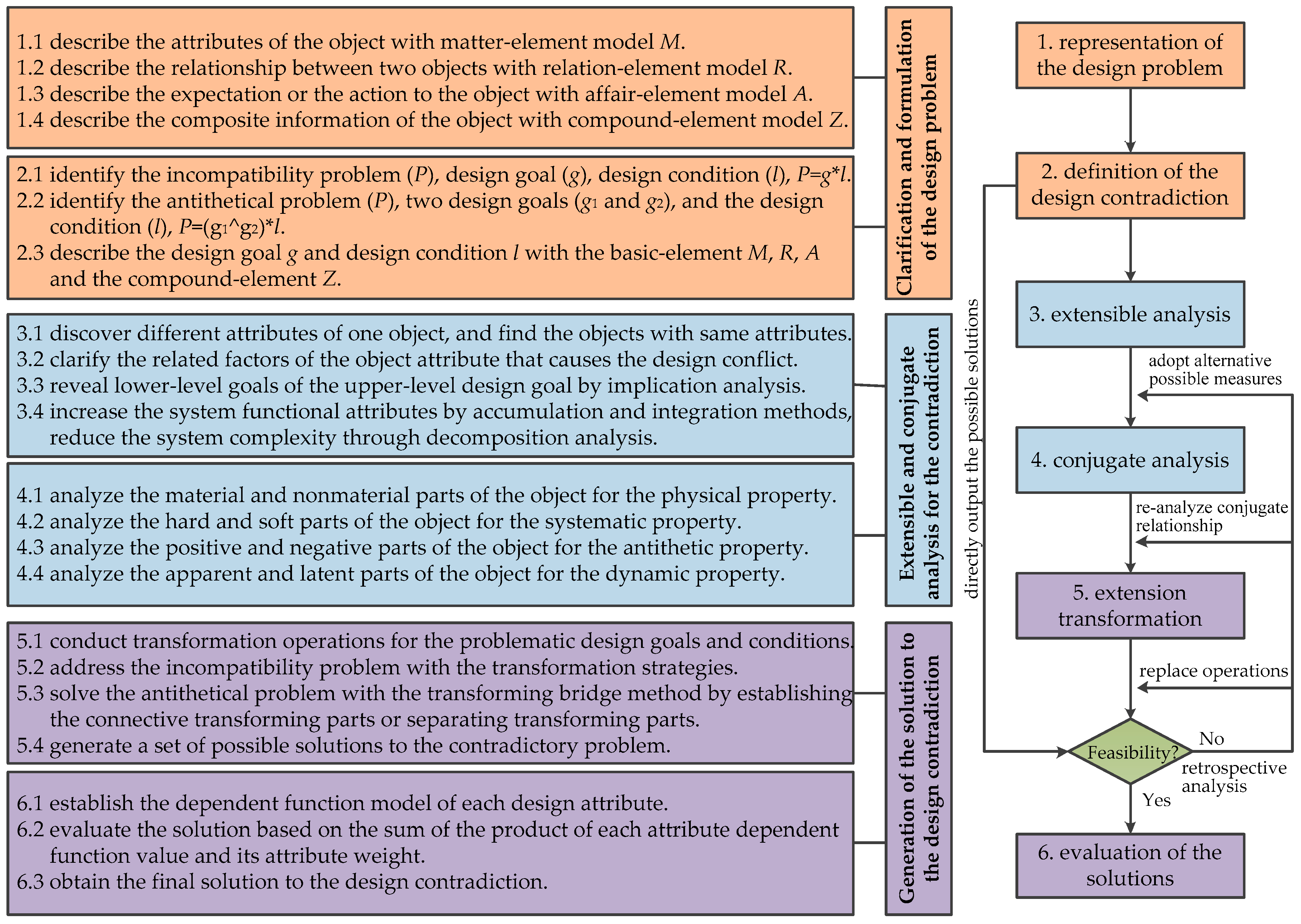

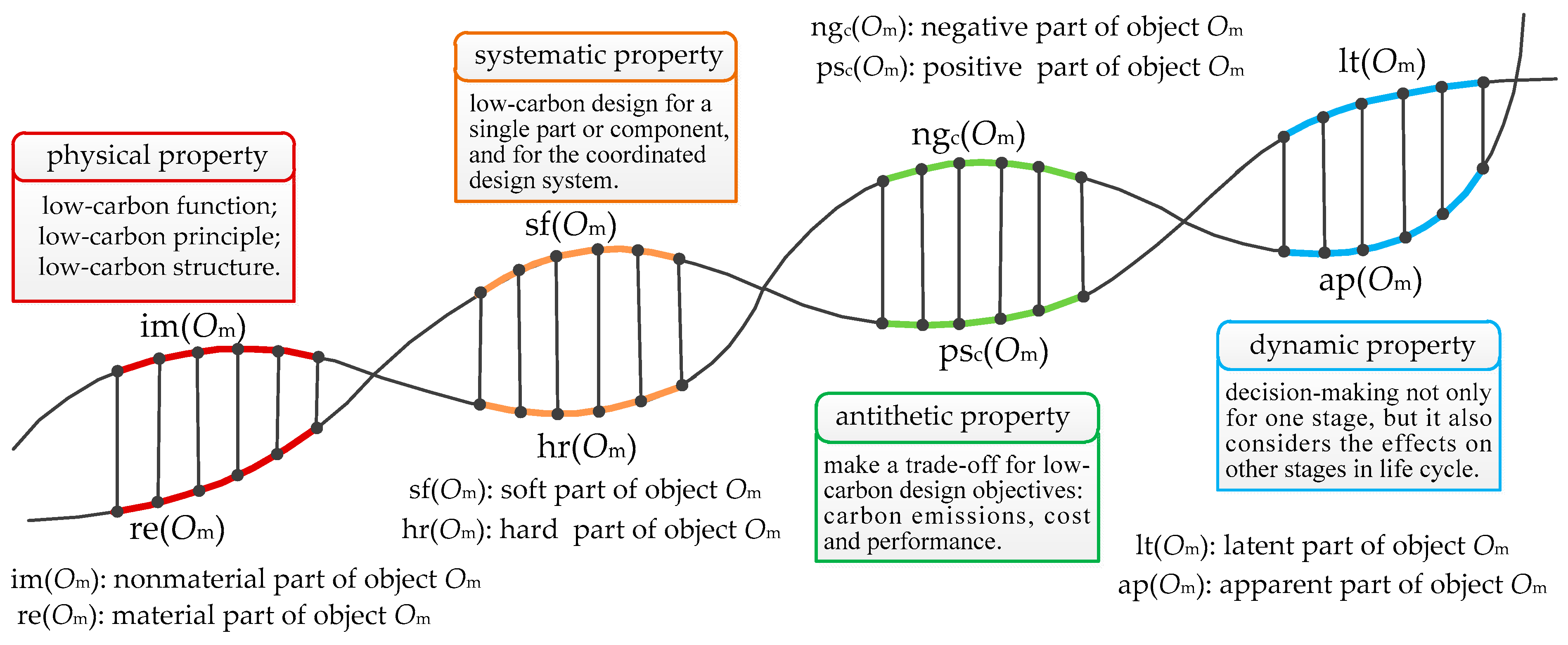
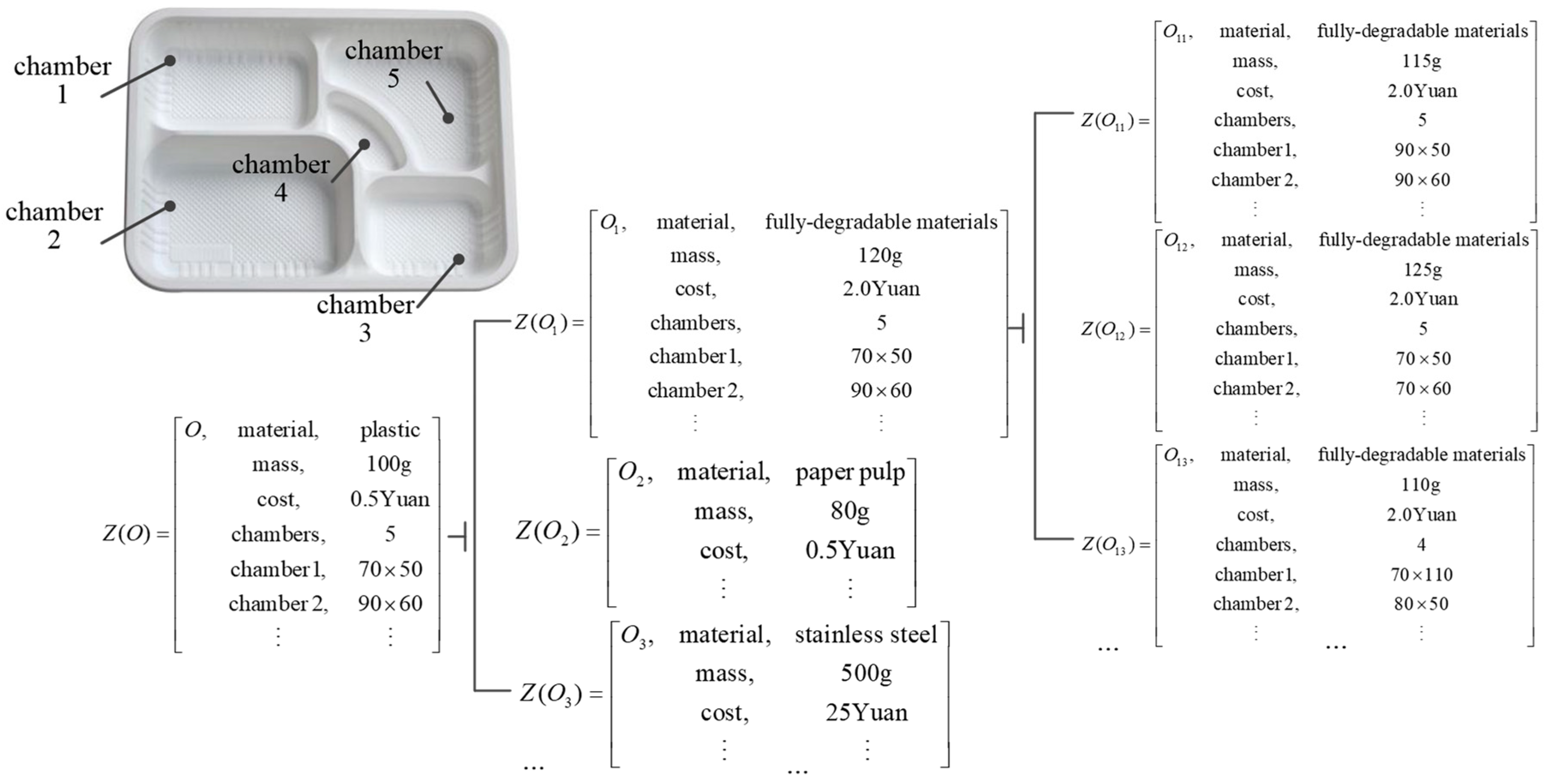
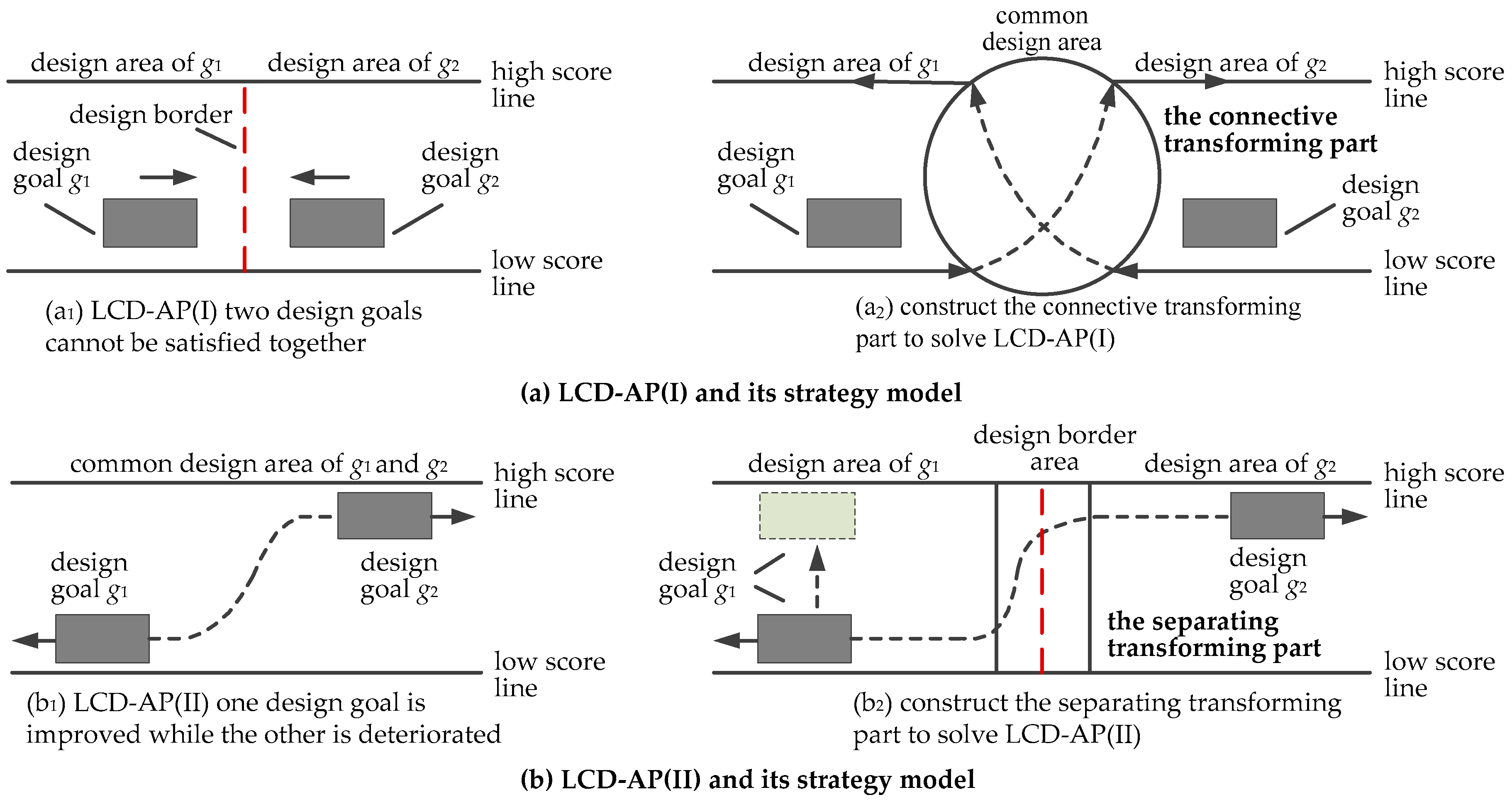


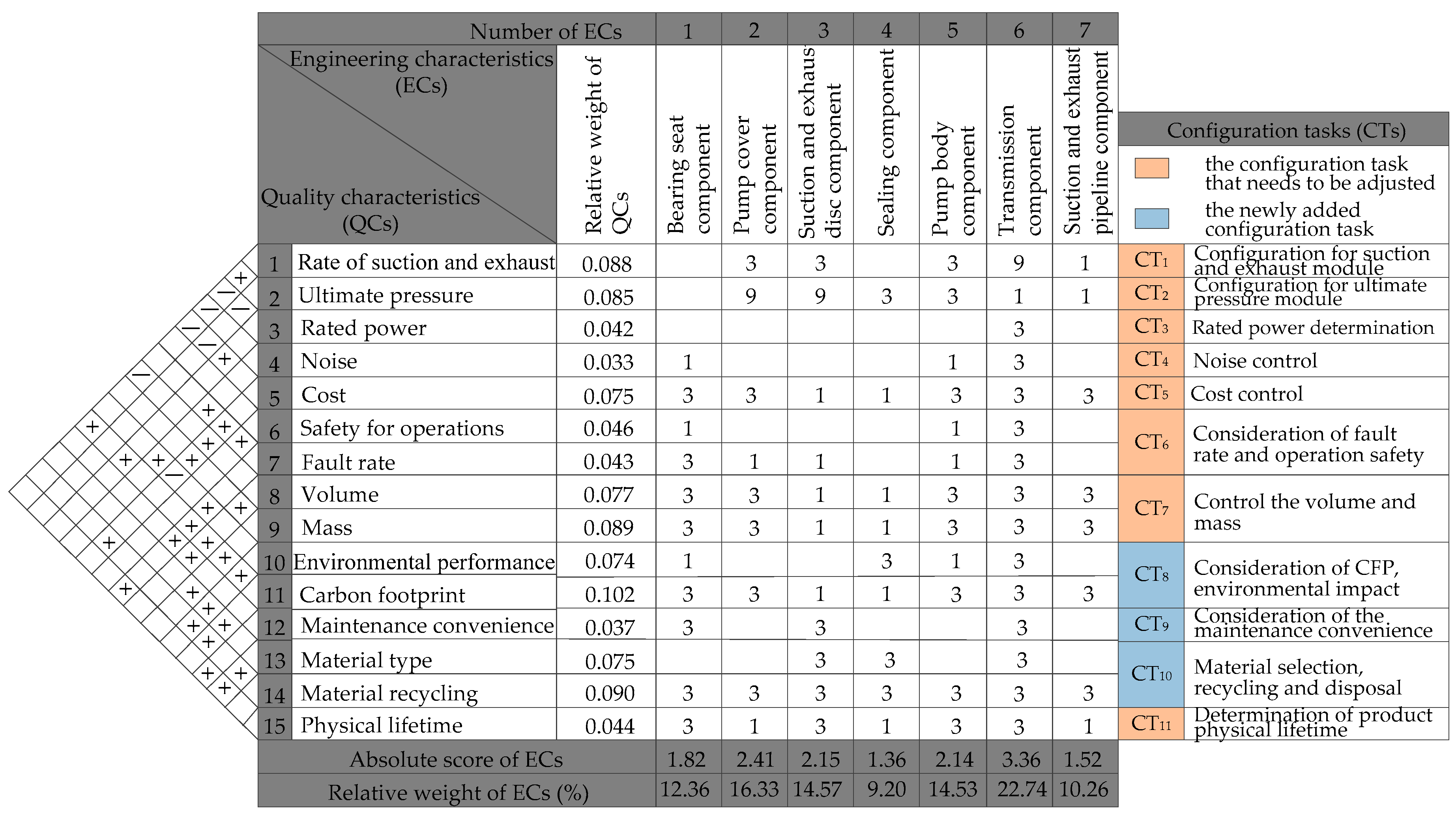
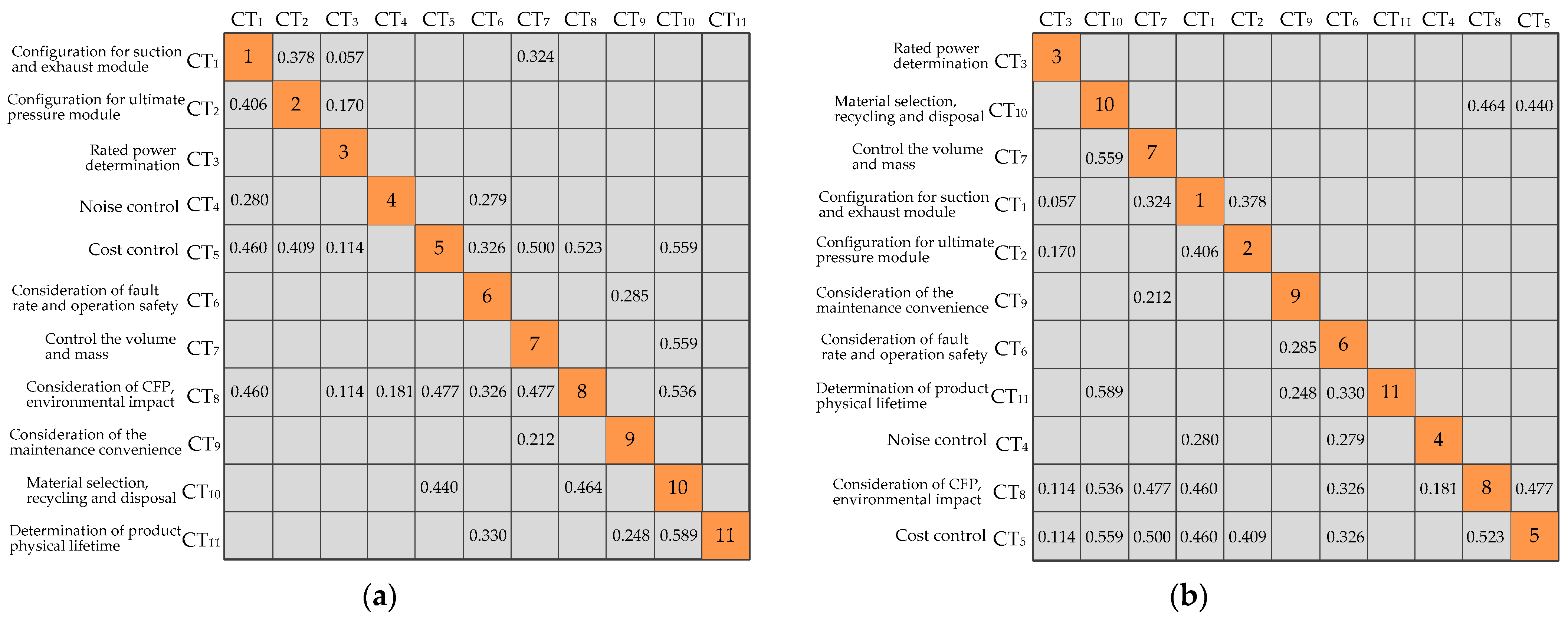
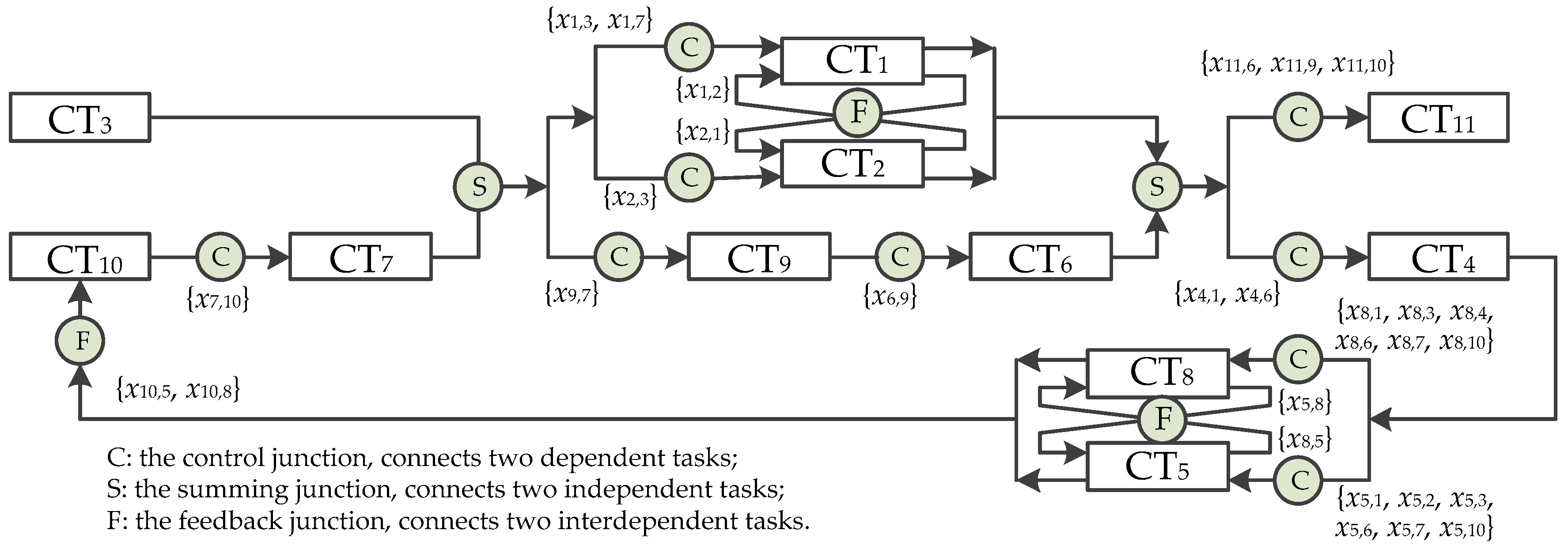
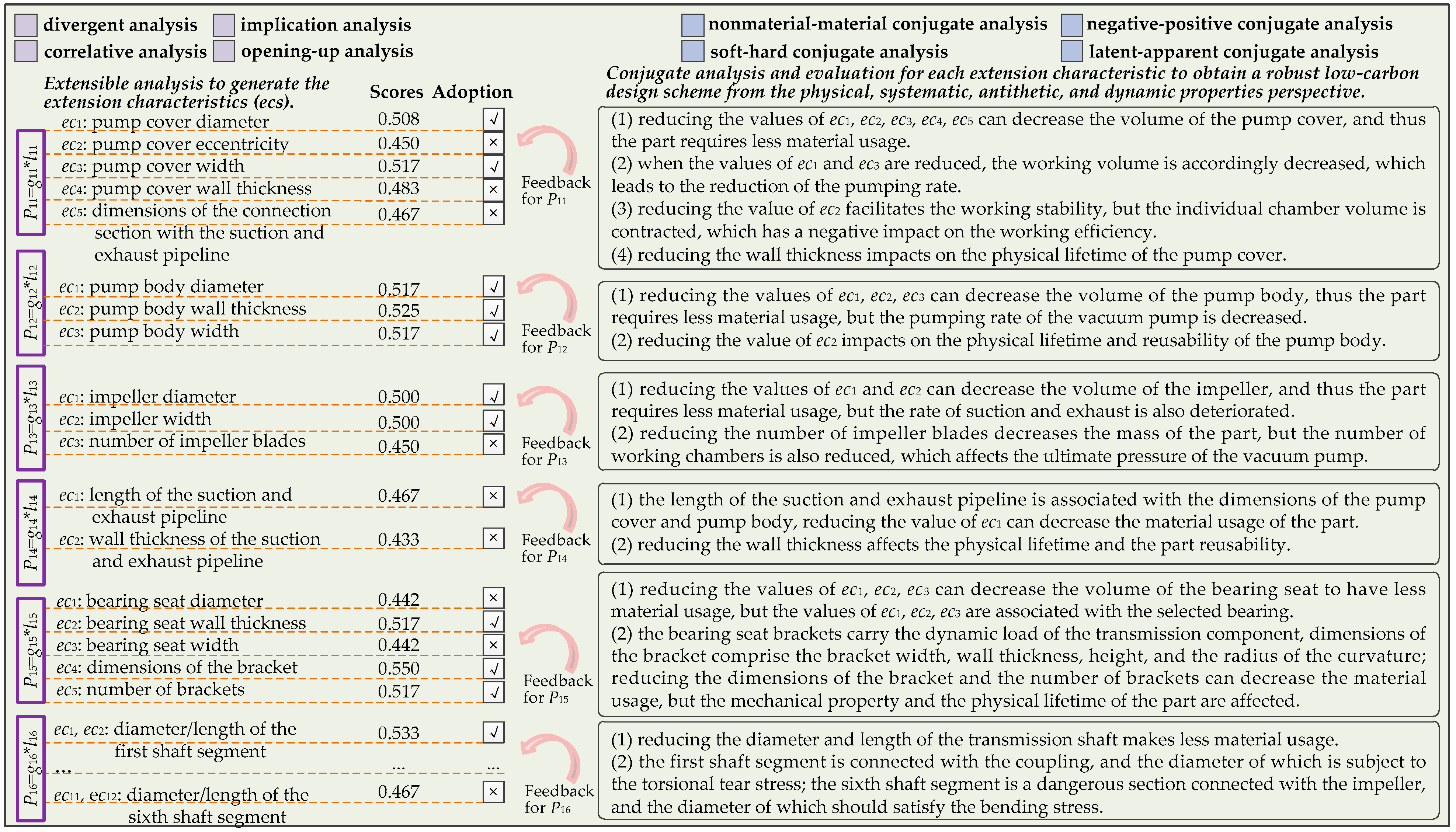



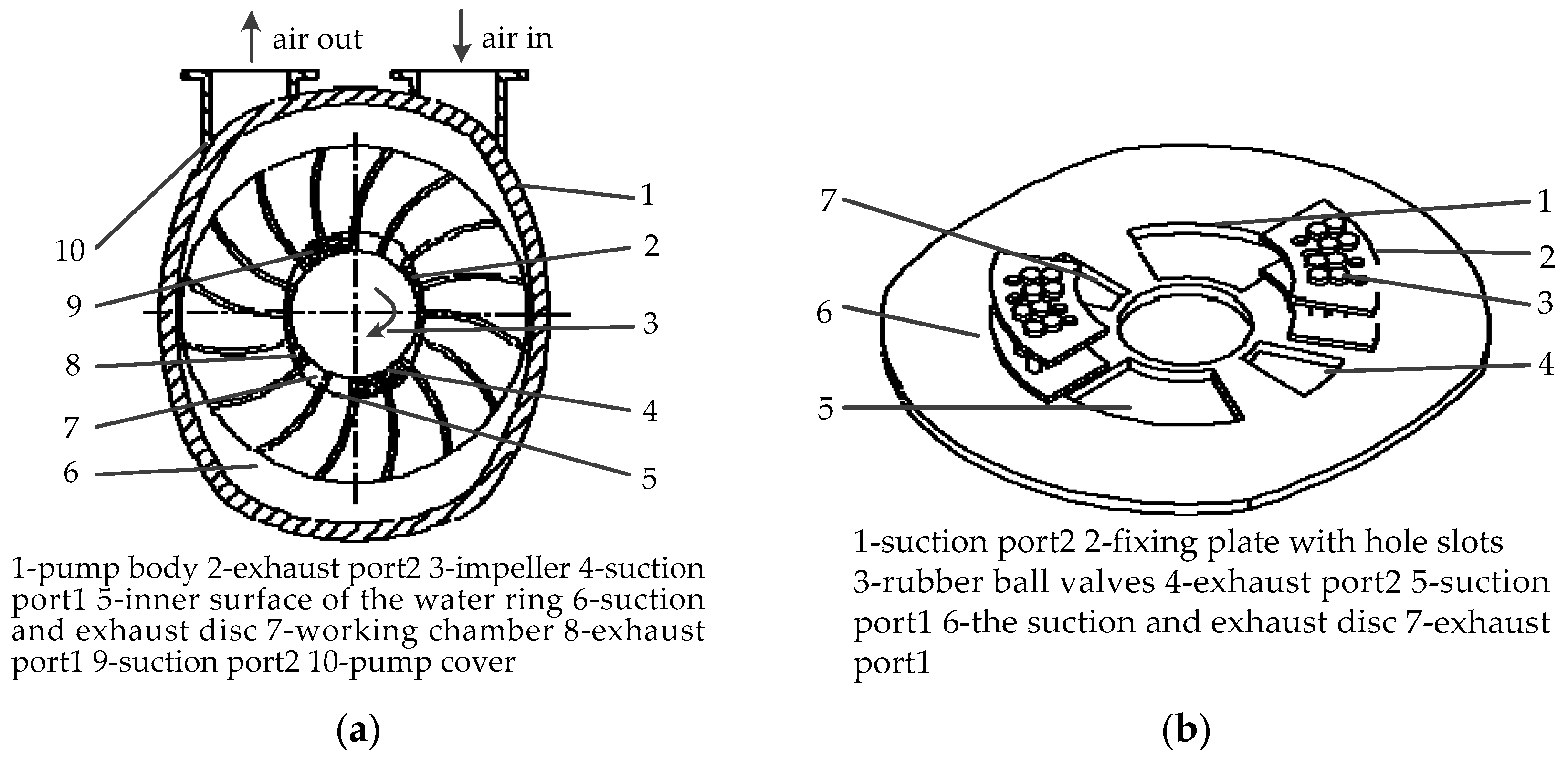
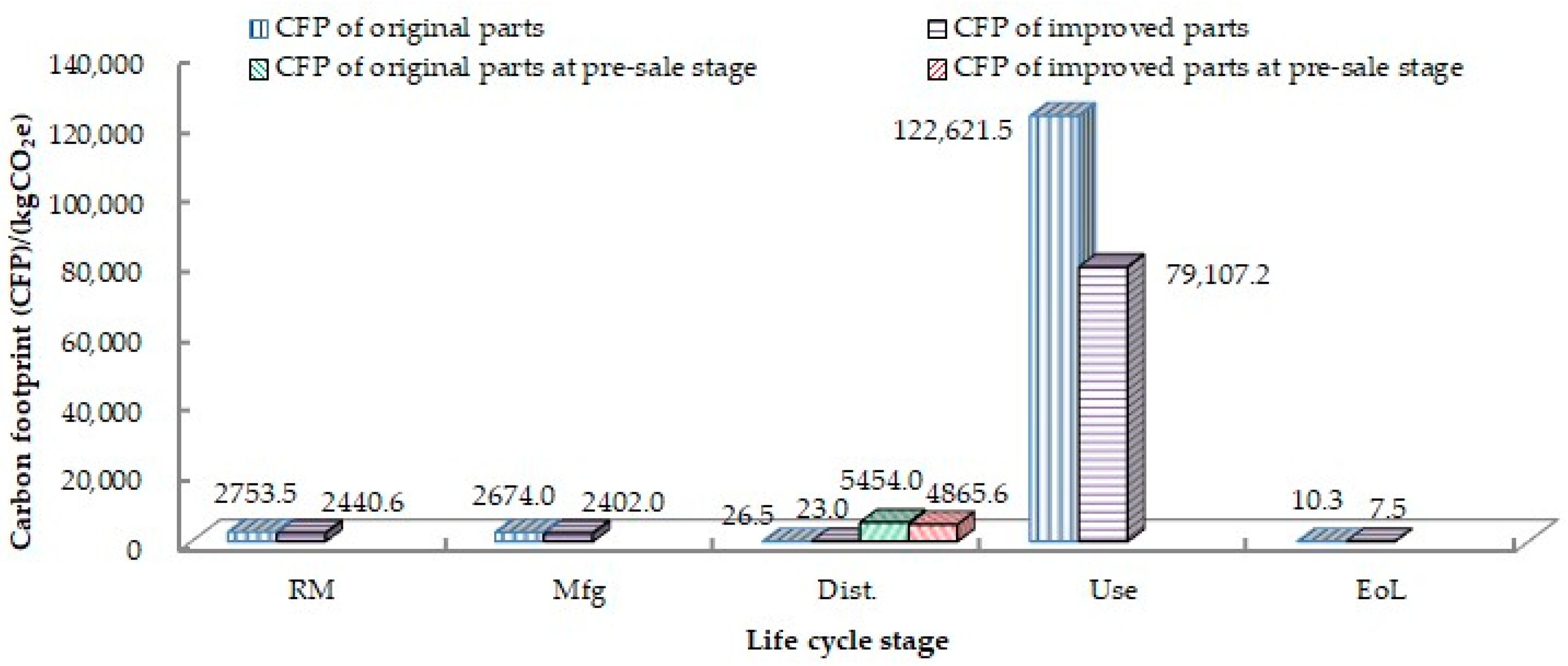

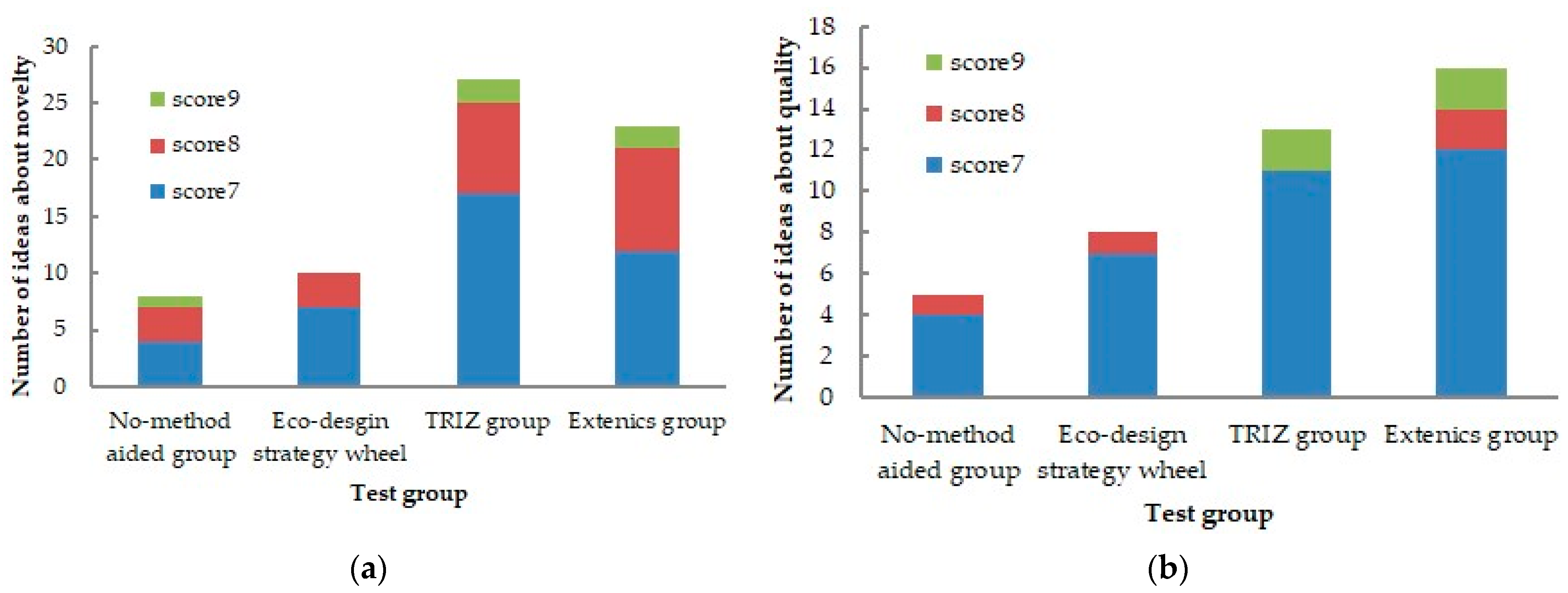
 | |
| (a) matter-element model of the impeller. m: impeller (part 15). | (b) relation-element model of the shaft and impeller. r: assembly relationship (part 6 and part 15). |
| (c) affair-element model of the shaft to reduce CFP. a1: reduce CFP. | (d) compound-element model of transmission components. O: transmission component (cpt 6). |
| Components and Parts | CFP of Parts at Each Life Cycle Stage | CFP_Part | |||||
|---|---|---|---|---|---|---|---|
| RM | Mfg | Dist. | Use | EoL | |||
| cpt1 | (18) bearing seat × 2 | 117.37 | 123.16 | 1.09 | 65.04 | 4.35 | 311.01 |
| (19) bearing × 2 | 45.81 | 9.55 | 0.52 | 180.76 | 0.29 | 236.92 | |
| (21) front bearing seat gland | 35.66 | 37.74 | 0.33 | 40.50 | 1.29 | 115.52 | |
| (5) rear bearing seat gland | 24.09 | 26.47 | 0.22 | 40.50 | 0.89 | 92.18 | |
| (22) gland washer ×2 | 1.59 | 1.88 | 0.01 | 41.72 | 0.002 | 45.20 | |
| cpt2 | (1) pump cover × 2 | 1298.03 | 1282.15 | 12.03 | 180.76 | 1.45 | 2774.43 |
| (17) pump cover gland × 2 | 18.62 | 21.25 | 0.17 | 40.50 | 0.70 | 81.25 | |
| cpt3 | (12) suction and exhaust disc × 2 | 90.52 | 101.22 | 0.42 | 52.77 | 0.144 | 245.08 |
| cpt4 | (11) profiling seal ring × 2 | 1.72 | 2.07 | 0.34 | 44.96 | 1.15 | 50.24 |
| (9) sealing packing × 2 | 4.72 | 0.40 | 0.26 | 78.13 | 6.29 | 89.80 | |
| (8) sealing gland × 2 | 10.05 | 11.28 | 0.53 | 133.62 | 0.01 | 155.50 | |
| (10) front bushing × 2 | 4.81 | 5.64 | 0.04 | 76.75 | 0.01 | 87.25 | |
| (7) rear bushing × 2 | 13.36 | 15.68 | 0.12 | 111.77 | 0.01 | 140.94 | |
| cpt5 | (2) pump body | 559.54 | 559.78 | 5.19 | 110.63 | 0.47 | 1235.60 |
| (13) seal ring × 2 | 1.17 | 1.17 | 0.19 | 36.96 | 0.62 | 40.12 | |
| (14) tightening bolt × 6 | 6.30 | 0.15 | 1.53 | 25.90 | 0.10 | 33.99 | |
| cpt6 | (6) transmission shaft | 105.64 | 11.96 | 2.15 | 110.63 | 0.16 | 230.55 |
| (15) impeller | 298.88 | 292.91 | 2.97 | 110.63 | 0.19 | 705.59 | |
| (20) connection key × 2 | 0.91 | 4.49 | 0.43 | 53.46 | 0.005 | 59.29 | |
| cpt7 | (24) suction and exhaust pipeline × 2 | 187.01 | 196.00 | 1.73 | 180.76 | 0.64 | 566.15 |
| Configuration Task CTi | Input Parameter xi,j | Output Parameter xj,i |
|---|---|---|
| CT1 configuration for suction and exhaust module | x1,2 ultimate pressure; x1,3 rated power x1,7 volume of the working chamber | x2,1, x4,1, x5,1, x8,1 |
| CT2 configuration for ultimate pressure module | x2,1 rate of the suction and exhaust; x2,3 rated power | x1,2, x5,2 |
| CT3 rated power determination | x1,3, x2,3, x5,3, x8,3 | |
| CT4 noise control | x4,1 effect of the pumping rate to the noise x4,6 noise stems from the mechanical faults | x8,4 |
| CT5 cost control | x5,1 cost with different pumping rates x5,2 cost with different ultimate pressure needs x5,3 cost with different rated power needs x5,6 cost of faults diagnosis and maintenance x5,7 cost of mechanical parts x5,8 cost of the environmental measures x5,10 cost of materials of parts and the recycling | x8,5, x10,5 |
| CT6 consideration of fault rate and operation safety | x6,9 maintenance and faults resolution for components | x4,6, x5,6, x8,6, x11,6 |
| CT7 control the volume and mass | x7,10 materials of the parts | x1,7, x5,7, x8,7, x9,7 |
| CT8 consideration of CFP, environmental impact | x8,1 rate of suction and exhaust x8,3 rated power x8,4 noise of the product x8,5 cost for the environmental demands x8,6 fault rate of the components x8,7 materials usage of the parts x8,10 material types, recycling and disposal methods | x5,8, x10,8 |
| CT9 consideration of the maintenance convenience | x9,7 volume and mass of the parts | x6,9, x11,9 |
| CT10 material selection, recycling, and disposal | x10,5 cost constraint for material selection, recycling, and disposal x10,8 environmental demands for material selection, recycling and disposal | x5,10, x7,10, x8,10, x11,10 |
| CT11 determination of product physical lifetime | x11,6 fault rate of the components x11,9 maintenance convenience for the parts x11,10 service life of materials for the parts |
| Design Problem | Description of the Design Goal | Description of the Design Condition |
|---|---|---|
| P11 = g11 * l11 | g11: reduce the volume and mass of the pump cover | l11: design information of the pump cover (part1) |
| P12 = g12 * l12 | g12: reduce the volume and mass of the pump body | l12: design information of the pump body (part2) |
| P13 = g13 * l13 | g13: reduce the volume and mass of the impeller | l13: design information of the impeller (part15) |
| P14 = g14 * l14 | g14: reduce the volume and mass of the suction and exhaust pipeline | l14: design information of the suction and exhaust pipeline (part24) |
| P15 = g15 * l15 | g15: reduce the volume and mass of the bearing seat | l15: design information of bearing seat (part18) |
| P16 = g16 * l16 | g16: reduce the volume and mass of the shaft | l16: design information of the shaft (part6) |
| P21 = g21 * l21 | g21: reduce the inner power consumption | l21: design information of the suction and exhaust disc (part12) |
| P22 = g22 * l22 | g22: improve the work efficiency | l22: working state of the vacuum pump |
| P31 = g31 * l31 | g31: improve the reusability of parts | l31: design information of part1, 2, 6, 12, 15, 18, 24 |
| P32 = g32 * l32 | g32: improve the adaptability of parts | l32: design information of part12, 24 |
| Design Problem | Description of the Design Goal | Description of the Design Condition |
|---|---|---|
| P1 = g1 * l1 | g1: maintenance of continuous working parts | l1: design information of part 6, 15, 18, 19 |
| P2 = g2 * l2 | g2: maintenance of the sealing parts | l2: design information of part 7, 8, 9, 10, 11 |
| Design Problem | Description of the Design Goal | Description of the Design Condition |
|---|---|---|
| P11 = g11 * l11 | g11: material selection of the shaft | l11: design information of the shaft (part6) |
| P12 = g12 * l12 | g12: material selection of the impeller | l12: design information of the impeller (part15) |
| P21 = g21 * l21 | g21: recycling measures for the parts | l21: current recycling measures for the parts |
| P22 = g22 * l22 | g22: disposal measures for the parts | l22: current disposal measures for the parts |
| eci | Physical Property | Systematic Property | Antithetic Property | Dynamic Property | Score | |||||
|---|---|---|---|---|---|---|---|---|---|---|
| Material Part | Nonmaterial Part | Hard Part | Soft Part | Positive Part | Negative Part | Apparent Part | Latent Part | |||
| P21 | ec1 | M,M,M | P,M,P | G,M,M | G,M,M | M,M,M | M,M,M | M,G,M | M,P,VP | 0.483 |
| Mean = 0.50 | Mean = 0.37 | Mean = 0.57 | Mean = 0.57 | Mean = 0.50 | Mean = 0.50 | Mean = 0.57 | Mean = 0.30 | |||
| ec2 | M,M,M | P,M,M | M,G,M | G,M,M | M,M,M | P,M,P | M,M,P | M,P,P | 0.467 | |
| Mean = 0.50 | Mean = 0.43 | Mean = 0.57 | Mean = 0.57 | Mean = 0.50 | Mean = 0.37 | Mean = 0.43 | Mean = 0.37 | |||
| ec3 | M,M,G | G,G,VG | M,M,M | M,M,G | G,M,G | M,M,M | G,M,M | G,M,G | 0.592 | |
| Mean = 0.57 | Mean = 0.77 | Mean = 0.50 | Mean = 0.57 | Mean = 0.63 | Mean = 0.50 | Mean = 0.57 | Mean = 0.63 | |||
| P22 | ec1 | M,M,M | M,M,G | P,M,P | P,M,P | M,M,G | M,P,P | M,M,P | M,M,G | 0.467 |
| Mean = 0.50 | Mean = 0.57 | Mean = 0.37 | Mean = 0.37 | Mean = 0.57 | Mean = 0.37 | Mean = 0.43 | Mean = 0.57 | |||
| ec2 | M,P,M | G,M,G | M,P,P | M,P,M | G,M,M | M,P,P | P,M,P | M,G,M | 0.467 | |
| Mean = 0.43 | Mean = 0.63 | Mean = 0.37 | Mean = 0.43 | Mean = 0.57 | Mean = 0.37 | Mean = 0.37 | Mean = 0.57 | |||
| ec3 | M,M,M | G,M,G | M,P,M | M,M,G | G,M,G | M,P,M | M,M,G | G,M,G | 0.550 | |
| Mean = 0.50 | Mean = 0.63 | Mean = 0.43 | Mean = 0.57 | Mean = 0.63 | Mean = 0.43 | Mean = 0.57 | Mean = 0.63 | |||
| P31 | ec1 | M,G,M | M,G,M | M,G,M | M,G,M | M,G,G | M,M,P | M,M,P | G,G,M | 0.550 |
| Mean = 0.57 | Mean = 0.57 | Mean = 0.57 | Mean = 0.57 | Mean = 0.63 | Mean = 0.43 | Mean = 0.43 | Mean = 0.63 | |||
| ec2 | M,M,M | M,M,M | M,M,M | M,M,M | G,M,M | M,M,M | M,M,P | G,M,M | 0.508 | |
| Mean = 0.50 | Mean = 0.50 | Mean = 0.50 | Mean = 0.50 | Mean = 0.57 | Mean = 0.50 | Mean = 0.43 | Mean = 0.57 | |||
| ec3 | G,M,M | M,M,M | G,M,M | M,M,M | G,M,G | M,M,P | G,M,M | M,M,M | 0.533 | |
| Mean = 0.57 | Mean = 0.50 | Mean = 0.57 | Mean = 0.50 | Mean = 0.63 | Mean = 0.43 | Mean = 0.57 | Mean = 0.50 | |||
| P32 | ec1 | M,M,G | G,G,G | M,M,M | M,G,M | G,M,G | M,P,M | G,M,M | G,M,G | 0.575 |
| Mean = 0.57 | Mean = 0.70 | Mean = 0.50 | Mean = 0.57 | Mean = 0.63 | Mean = 0.43 | Mean = 0.57 | Mean = 0.63 | |||
| ec2 | G,M,M | G,M,M | M,M,M | M,M,M | G,G,M | M,M,P | M,M,M | G,G,M | 0.542 | |
| Mean = 0.57 | Mean = 0.57 | Mean = 0.50 | Mean = 0.50 | Mean = 0.63 | Mean = 0.43 | Mean = 0.50 | Mean = 0.63 | |||
| cpti | The Original Design Scheme | The Improved Design Scheme |
|---|---|---|
| cpt1 | (1) bearing seat wall thickness is 20 mm; (2) dimensions of the bracket of the bearing seat: the bracket width is 36 mm, the wall thickness is 8 mm; (3) number of the bracket is three; (4) the bearing seat is designed for material recycling. | the bearing seat stands the dynamic load of the transmission component; it should make a trade-off between the size reduction and the mechanical demand: the bearing seat wall thickness is 16 mm; the bracket width is 40 mm, bracket wall thickness is 15 mm, the number of brackets is two; the bearing seat is redesigned for reuse. |
| cpt2 | (1) the cross-sectional shape of the pump cover is a circle; (2) the pump cover diameter is 480 mm, the width is 124 mm; (3) the eccentricity of the pump cover is 30 mm. | adaptation for the pump cover: the cross-sectional shape is similar to an ellipse, the diameter is 540 mm, the width is 156mm, the eccentricity is zero; air passages are redesigned to satisfy the function of suction and exhaust twice in one working revolution. |
| cpt3 | (1) the suction and exhaust disc has one suction port and one exhaust port; (2) there is no pressure-adjusting component applied; (3) the suction and exhaust disc is designed for material recycling. | the suction and exhaust disc is modified to improve its reusability and adaptability: it has two pairs of suction and exhaust ports to meet the requirement of suction and exhaust twice in one working revolution; the pressure-adjusting component is designed to reduce the inner power consumption; the part is redesigned for reuse. |
| cpt4 | the shape of the profiling seal ring is a circle. | the profiling seal ring is replaced by an oval-shaped one. |
| cpt5 | (1) the cross-sectional shape of the pump body is a circle; (2) the pump body diameter is 480 mm, the wall thickness is 30 mm; the width is 235 mm; (3) the pump body is designed for material recycling. | adaptation for the pump body: the cross-sectional shape is similar to an ellipse, the diameter is 540 mm, the wall thickness is 16 mm, the width is 210 mm; the pump body is redesigned for reuse by remanufacturing. |
| cpt6 | (1) the impeller material is copper, the diameter is 400 mm, the width is 235 mm; (2) the material of the shaft is 45#, diameter of the first shaft segment is 60 mm. | adaptation for the impeller and the shaft: the material of the impeller is still copper, the diameter is 450 mm, the width is 210 mm; the material of the shaft is still 45#, diameter of the first shaft segment is 40 mm. |
| cpt7 | the length of the suction and exhaust pipeline is fixed, which depends on the length of the pump cover and pump body. | the length of the suction and exhaust pipeline can be adjusted, it can be reused for the series vacuum pumps. |
| Group | Arrangement | Data Collection and Metrics |
|---|---|---|
| No-method aided group | 30 min: description of the task; 2 h: design problem clarification and idea generation. | The ideas generated could be recorded by sound and sketch. Each method was measured by evaluating the ideas generated with two process-based criteria: quantity and variety, and two result-based criteria: novelty and quality. |
| Eco-design strategy wheel group | 2 h: training students in this group for the eco-design strategy wheel method; 30 min: description of the task; 2 h: design problem clarification and idea generation. | |
| TRIZ group | 1 day: training students in this group for TRIZ method; 30 min: description of the task; 2 h: design problem clarification and idea generation. | |
| Extenics group | 1 day: training students in this group for Extenics; 30 min: description of the task; 2 h: design problem clarification and idea generation. |
| Levels of Generated Ideas | No-Method Aided Group | Eco-Design Strategy Wheel Group | TRIZ Group | Extenics Group |
|---|---|---|---|---|
| Functional principle | 2 | 3 | 8 | 6 |
| Structure layout | 7 | 6 | 12 | 21 |
| Structure parameter | 11 | 12 | 19 | 16 |
| Low-carbon related strategy | 3 | 8 | 8 | 9 |
| Criterion | Description of the Scoring Rule | ||
|---|---|---|---|
| Score = 1 | Score = 2 | Score = 3 | |
| Novelty | Function realization with conventional principle and structure layout. | Function realization with novel principle and structure layout. | Function realization with novel principle and structure layout, and the design scheme has good environmental improvement potential. |
| Quality | Specifications of low-carbon related quality characteristics were satisfied, but the specifications of the basic quality characteristics could not be met. | Specifications of basic quality characteristics were satisfied, but specifications of low-carbon related quality characteristics could not be met. | Both specifications of basic quality characteristics and low-carbon related quality characteristics were satisfied. |
Publisher’s Note: MDPI stays neutral with regard to jurisdictional claims in published maps and institutional affiliations. |
© 2021 by the authors. Licensee MDPI, Basel, Switzerland. This article is an open access article distributed under the terms and conditions of the Creative Commons Attribution (CC BY) license (https://creativecommons.org/licenses/by/4.0/).
Share and Cite
Ren, S.; Gui, F.; Zhao, Y.; Zhan, M.; Wang, W.; Zhou, J. An Extenics-Based Scheduled Configuration Methodology for Low-Carbon Product Design in Consideration of Contradictory Problem Solving. Sustainability 2021, 13, 5859. https://doi.org/10.3390/su13115859
Ren S, Gui F, Zhao Y, Zhan M, Wang W, Zhou J. An Extenics-Based Scheduled Configuration Methodology for Low-Carbon Product Design in Consideration of Contradictory Problem Solving. Sustainability. 2021; 13(11):5859. https://doi.org/10.3390/su13115859
Chicago/Turabian StyleRen, Shedong, Fangzhi Gui, Yanwei Zhao, Min Zhan, Wanliang Wang, and Jianqiang Zhou. 2021. "An Extenics-Based Scheduled Configuration Methodology for Low-Carbon Product Design in Consideration of Contradictory Problem Solving" Sustainability 13, no. 11: 5859. https://doi.org/10.3390/su13115859
APA StyleRen, S., Gui, F., Zhao, Y., Zhan, M., Wang, W., & Zhou, J. (2021). An Extenics-Based Scheduled Configuration Methodology for Low-Carbon Product Design in Consideration of Contradictory Problem Solving. Sustainability, 13(11), 5859. https://doi.org/10.3390/su13115859






